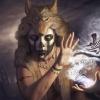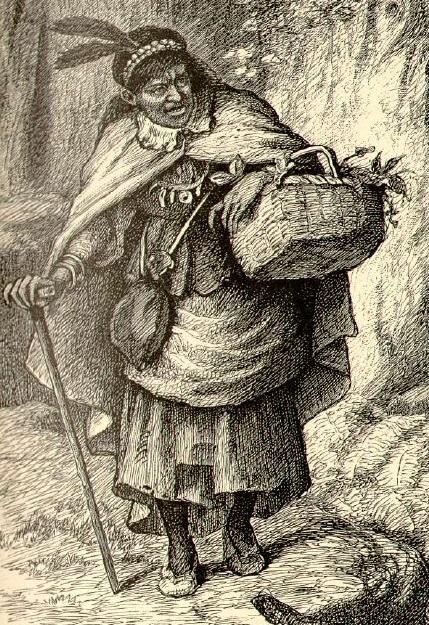 Submitted by Shaman De-na on
Submitted by Shaman De-na on

By Henry Wadsworth Longfellow - "Giles Corey of the Salem Farms" (1868) (Houghton, Mifflin & Co.), in The Complete Poetical Works of Henry Wadsworth Longfellow, Boston, 1902, Public Domain, https://commons.wikimedia.org/w/index.php?curid=52338165
Sometimes history and lore need to be corrected ...
Tituba is one of the key figures in the Salem witch trials. A slave owned by Reverend Parris of Salem Village, she was one of the first people accused of being a witch. She was also one of the first people to accuse others of witchcraft while she was on the stand.
I think it's well-known these days that ethnically Tituba was an Arawak Indian. Reverend Parris and his family had lived as plantation owners for many years in the Caribbean, the Arawak homeland. It seems likely the Parrises purchased Tituba and her husband John as slaves while living in Barbados.
Although historians know that Tituba was an Indian, pop culture tends to portray her as being of African descent. (For example, on the TV show Salem Tituba is played by a black actress and speaks with a Caribbean accent.) For many years I also thought she was black, based on what I had learned when I was a kid.
So how did Tituba become black in the popular American imagination? Historian Ben Ray's 2015 book Satan and Salem gives some clues.
Ray claims that it started with famous New England poet Henry Wadsworth Longfellow. In 1868 Longfellow published a work called the New England Tragedies, which included the play Giles Corey of the Salem Farms. Tituba is one of the main characters.
As the play opens, Tituba is in the woods outside Salem. As she gathers herbs to work evil magic she says:
I know them (herbs), and the places where they hide
In field and meadow; and I know their secrets,
And gather them because they give me power
Over all men and women. Armed with these,
I, Tituba, an Indian and a slave,
Am stronger than the captain with his sword,
Am richer than the merchant with his money,
Am wiser than the scholar with his books,
Mightier than Ministers and Magistrates...
So it's pretty clear that Tituba is an Indian in this play, correct? Well, things get a little murkier in a later scene where Tituba asks Mary Walcott to look into a mirror as part of a magic spell:
TITUBA.
Look into this glass.
What see you?
MARY.
Nothing but a golden vapor.
Yes, something more. An island, with the sea
Breaking all round it, like a blooming hedge.
What land is this?
TITUBA.
It is San Salvador,
Where Tituba was born. What see you now?
MARY.
A man all black and fierce.
TITUBA.
That is my father.
He was an Obi man, and taught me magic,
Taught me the use of herbs and images...
In Longellow's play Tituba's father is not only black, he taught her Obi (or Obeah), which is a system of African-derived magical and religious practices similar to Voudoun/Voodoo. There's no evidence that any of this is true. As far as historians know, Tituba's father was not of African descent and she didn't know Obeah or Voodoo. The only magical act she undertook - making a witch cake out of rye and urine - was done at the behest of Mary Sibley, an Englishwoman who lived near the Parrises. A witch cake is a form of English magic, not Voodoo.
Lonfellow was a popular writer, and Ray claims his play planted the idea that Tituba was at least partly black in the American imagination.
Although Ray doesn't discuss her, historian Marion Starkey probably helped perpetuate the image of Tituba as half-black and half-Arawak. Starkey describes her as "the ageless Tituba, said to be half Carib and half negro" in her popular 1949 book The Devil in Massachusetts. The text on the back cover of my copy describes it as "an authentic historical narrative," but Starkey's description of Tituba just isn't correct. Maybe she got it from Longfellow's play?
Starkey also incorrectly claimed Tituba taught the Salem girls Voodoo:
But there were presently occasions when, in the absence of the elder Parrises, Tituba yielded to the temptation to show the children tricks and spells, fragments of something like the voodoo remembered from the Barbados.
Starkey's books is still popular today.
Ray claims that another playwright, the 20th century's Arthur Miller, completed Tituba's transformation from Arawk to black. Like Giles Corey, Miller's 1953 play The Crucible features Tituba as a main character. The stage directions describe her this way:
The door opens, and his Negro slave enters. Tituba is in her forties. Parris brought her with him from Barbados, where he spent some years as a merchant before entering the ministry.
Tituba is not even half-Indian in Miller's play, but is entirely of African descent. That's a big difference between the two plays, but similar to Longfellow Miller also perpetuates the myth that Tituba knew some type of Caribbean magic. In The Crucible, she holds magic rituals in the woods with some of the Salem girls:
I saw Tituba waving her arms over the fire when I came on you. Why was she doing that? And I heard a screeching and gibberish coming from her mouth...
The Crucible is one of the classics of American theater. It's still performed frequently even today and is assigned to high school students all across the country as required reading.
Longellow and Miller weren't historians - they wrote plays and poetry based on history. Writers certainly are allowed artistic license with historic characters, but the challenge is that The Crucible is the main way many Americans learn about Salem.
It's a little strange that so many people think the Salem witch trials were started by a black Voodoo priestess, when that really wasn't the case at all. Our understanding of American slavery might be one of the reasons this myth keeps lingering. When Americans think of slaves in North America, they tend to picture people of African descent. It's obviously true that most slaves were black, but a very tiny percentage of them (like Tituba) weren't.
I also suspect, but have no way of proving, that maybe a little lingering racism and sexism help this myth persist. We now know that the Salem witch craze wasn't caused by a black woman, but for some reason a lot of us still think it was.
Peter Muise - http://newenglandfolklore.blogspot.com/2016/05/how-did-tituba-become-black.html